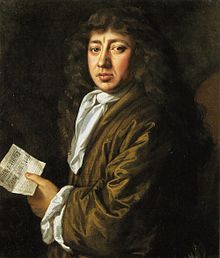Pepys's Diary
|
Samuel Pepys FRS |
|
|---|---|

Portrait of Pepys by John Hayls
|
|
| Born |
23 February 1633 London, England |
| Died | 26 May 1703 (aged 70) Clapham, Surrey, England |
| Resting place |
St Olave's, London, England 51°30′39″N 0°04′47″W / 51.510878°N 0.079627°W |
| Nationality | English |
| Education | Huntingdon Grammar School, St Paul's School and Cambridge University |
| Occupation |
Naval Administrator Chief Secretary to the Admiralty Tory Member of Parliament for Castle Rising and Harwich |
| Known for | Diary |
| Political party | Tory |
| Board member of | President of the Royal Society, Master of Trinity House, Freeman of the City of London, Freeman of Portsmouth, Treasurer of the Tangier Committee |
| Spouse(s) | Elisabeth Pepys (née de St Michel) |
| Relatives |
|
Samuel Pepys FRS (/ˈpiːps/ PEEPS; 23 February 1633 – 26 May 1703) was an administrator of the navy of England and Member of Parliament who is most famous for the diary that he kept for a decade while still a relatively young man. Pepys had no maritime experience, but he rose to be the Chief Secretary to the Admiralty under both King Charles II and King James II through patronage, hard work, and his talent for administration. His influence and reforms at the Admiralty were important in the early professionalisation of the Royal Navy.
The detailed private diary that Pepys kept from 1660 until 1669 was first published in the 19th century and is one of the most important primary sources for the English Restoration period. It provides a combination of personal revelation and eyewitness accounts of great events, such as the Great Plague of London, the Second Dutch War, and the Great Fire of London.
Pepys was born in Salisbury Court, Fleet Street, London on 23 February 1633, the son of John Pepys (1601–1680), a tailor, and Margaret Pepys (née Kite; died 1667), daughter of a Whitechapel butcher. His great uncle Talbot Pepys was Recorder and briefly Member of Parliament (MP) for Cambridge in 1625. His father's first cousin Sir Richard Pepys was elected MP for Sudbury in 1640, appointed Baron of the Exchequer on 30 May 1654, and appointed Lord Chief Justice of Ireland on 25 September 1655.
...
Wikipedia
